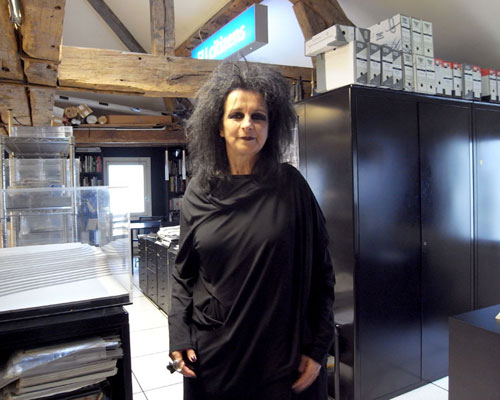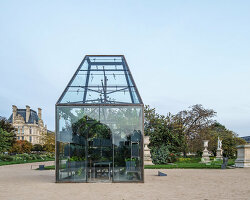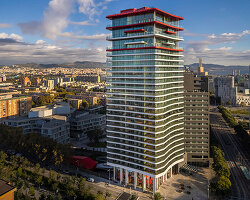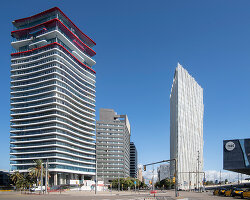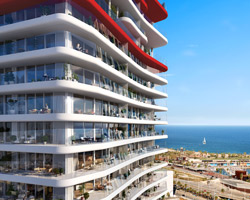odile decq portrait © designboom
— designboom met odile decq at her studio in paris, france on january 22, 2011. —
what is the best moment of the day?
the best moment of my day, depends on the day. it could be when I open my eyes and discover the sun is out, because paris is always grey. maybe at breakfast? and when I brush my teeth because they are times when ideas come to me. it’s very strange, but very often I will go to the office to work on a project and say, ‘this morning when I was brushing my teeth, I thought about that…’. or maybe it’s when I fall asleep!
what kind of music do you listen to at the moment?
I listen to everything except rap and jazz. I don’t know why, but I don’t like jazz even if I like blues, and I can’t listen to rap. I put many songs on my iPhone so I have music when I travel, and it is mainly rock, but some stravinsky and beethoven.
do you listen to the radio?
every morning I wake up with the radio and when I don’t sleep I listen to the radio at night until I leave in the morning. I love the radio.
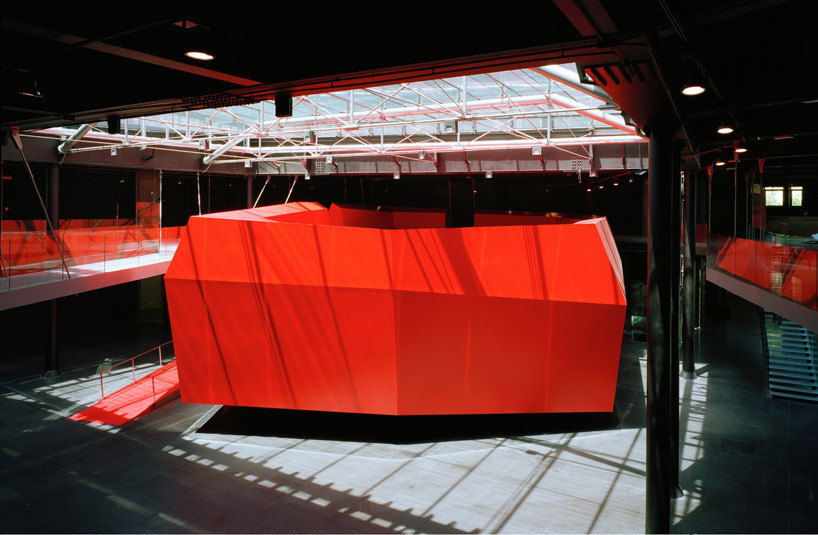 new wing of the MACRO museum in rome image by luigi filetici, courtesy of MACRO for more info and pictures of project, click here
new wing of the MACRO museum in rome image by luigi filetici, courtesy of MACRO for more info and pictures of project, click here
what books do you have on your bedside table?
I don’t have books on my bedside table because I don’t read in my bed. I feel that it is much too uncomfortable. I read in planes and trains a lot. mainly literature, but I went through a period of reading thrillers… at the moment, I am reading a book called ‘purge’ by finnish writer sofi oskanen which is quite good. it’s a novel about estonia during the second world war and soviet occupation. it’s really incredible. before that was ‘life’ by keith richards and it was fantastique! the way it was written, I wanted to know more and more. you discover the story of somebody different – it’s really all about ‘sex and drugs’.
do you read design / architecture / fashion magazines?
is there something to read in fashion magazines? (laughs) sometimes I look through at images because it’s something for leisure, to rest. it’s nice to read those on the train or plane. I don’t go through architectural magazines so often. at the beginning I read them a lot, but now I have no time and to read what architects are writing about themselves. most of the magazines in france, the text is written by the architects themselves, but it’s not interesting. it’s more engaging to look at the pictures, that’s all. this is a shame, but it’s like that.
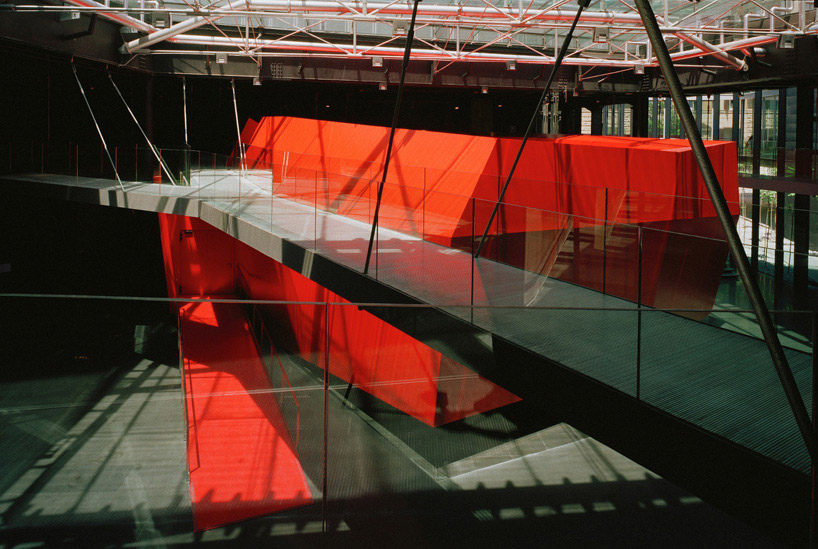 new wing of the MACRO museum in rome image by luigi filetici, courtesy of MACRO
new wing of the MACRO museum in rome image by luigi filetici, courtesy of MACRO
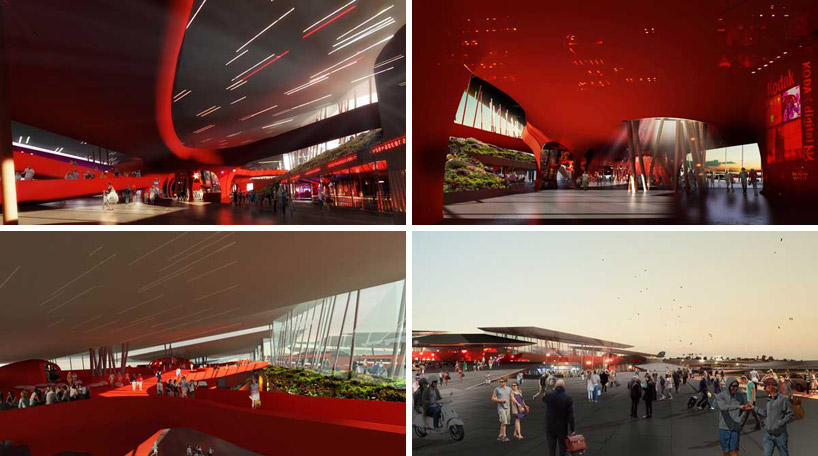 naples train station images courtesy of ODBC
naples train station images courtesy of ODBC
where do you get news from?
I don’t read the newspaper or watch the T.V. I am addicted to news magazines. l’express, le point, nouvel observateur, les écore… it’s a way for me to continue the information I get from the radio.
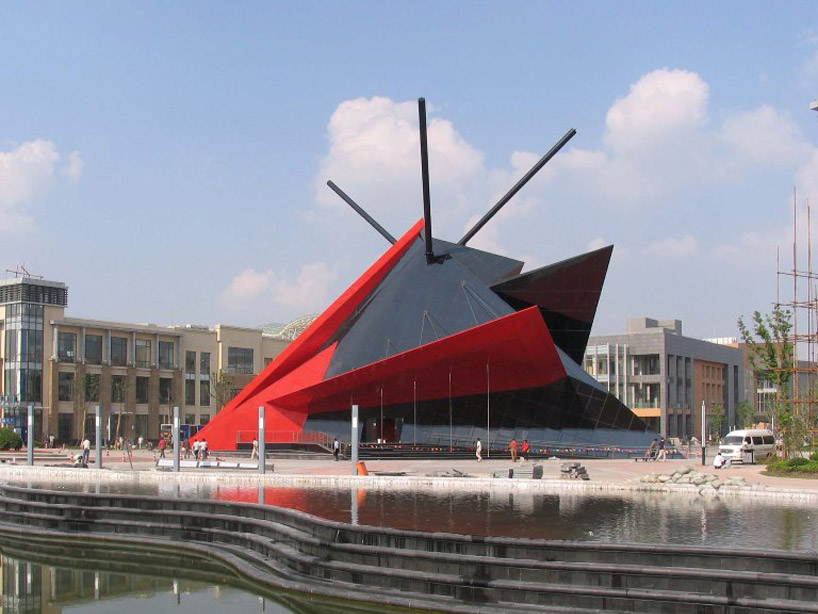 shanghai exhibition information centre image courtesy of OBDC
shanghai exhibition information centre image courtesy of OBDC
I assume you notice how women dress. do you have any preferences? generally for women?
my god. I can talk about men’s fashion if you want! I like when I meet somebody, a man, and I discover that the textile of what they are wearing, their jacket or pants looks like it is of good quality, I will ask them if I can touch it. I like when men take care about what they wear. this doesn’t mean they have to be very straight, traditional. they could be very extravagant. it doesn’t matter, as long as it’s very well done.
what kind of clothes do you avoid wearing?
anything which is not black.
do you have any pets?
no, because once I had a red fish and I killed it. I’m not good at taking care of animals, and I have no time for them.
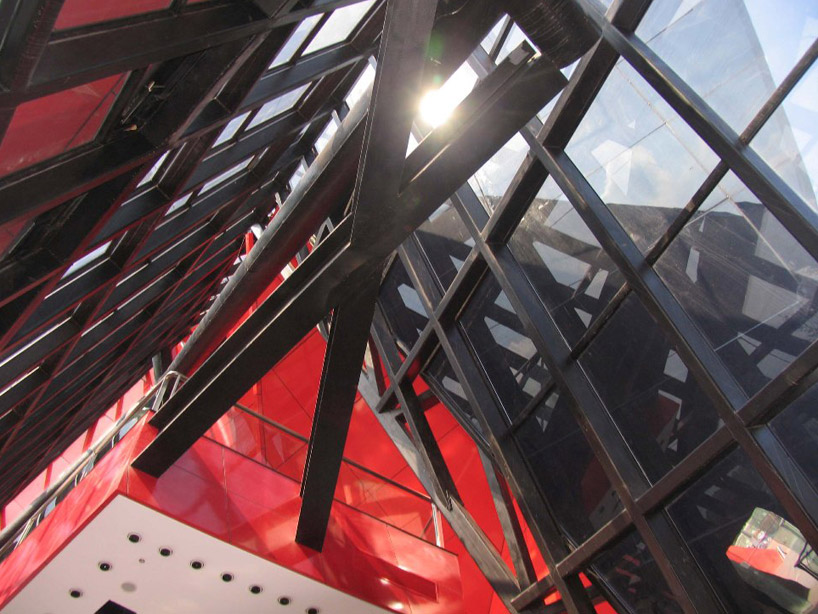 shanghai exhibition information centre image courtesy of OBDC
shanghai exhibition information centre image courtesy of OBDC
when you were a child, did you want to become an architect?
I had this idea when I was a teenager, but I thought at the time that to be an architect, you had to be very good at sciences, and you have to be a man – that it was a very male dominated field. I thought about art decoratif (decorative arts), but to do that I had to go to paris, and my parents didn’t want me to go to the city because I was a young girl and could get lost. so they asked me to go to the main capital in bretagne where I am from, which is near rennes, and studied art history for one year. there, I started to discover through meeting students in the school of architecture that I could have done my studies in architecture realizing its not obligatory to be good at math or science, and that it was not only for men but women too. so I passed the exam to enter the school, I applied for the school and succeeded. so, I started like that.
 rhône saône dévéloppement, (prrivate, commercial) pavillon 8 + archipel restaurant, france, 2007 image courtesy of OBDC
rhône saône dévéloppement, (prrivate, commercial) pavillon 8 + archipel restaurant, france, 2007 image courtesy of OBDC
where do you work on your designs and projects? do you also work at home? alone? or do you enjoy the moment of sharing an office?
in the office we work mostly like a workshop, by discussing and generating a dialogue about what I am thinking. sometimes I sketch when something comes to mind, but I have no real time to do everything myself. it’s impossible. ideas are coming when I travel, when I brush my teeth (as I said before), so when I meet people in the office who are in charge of a particular project, I tell them what I think, and I ask them to try that. I talk to them about what to change or keep. there’s always an exchange. that’s why I say it’s much more of a workshop than a personal attitude. I don’t like working alone. I prefer when there are at least two or three people to create an open dialogue.
do you discuss your work with other designers?
not people you are working with, but like, in the paris salon where people from different disciplines discuss cultural intent? I did that before, but now I don’t have time to get out of the office – I’m stuck here or in the school. I am also the director of a school of architecture, so I share my time between the two. that’s why we are here on a saturday. I ask people to come meet me on saturday and sunday afternoons usually, and they agree to come – the ones that need to come. this is the best time to work.
so you teach also? so maybe with teaching there is already a sort of discussion, a new generation…
exactly. coaching people to work. my preferred time is sunday afternoons. I don’t know why, but this is the best time to think, to design, to develop a project. sunday morning is the only time I don’t go to the school or the office.
and you don’t usually discuss with other architects? you don’t have this kind of clique?
the french scene for me is not so interesting to discuss with. I don’t want to sound arrogant when I say that, but because I travel so much, I am very open minded, and I love to meet new people from different countries and discuss with them. when I am abroad, I don’t only discuss architecture, but just about everything. about life in the cities, food, different cultures. this is my way of nourishing my ideas. I don’t have so many occasions to discuss in paris.
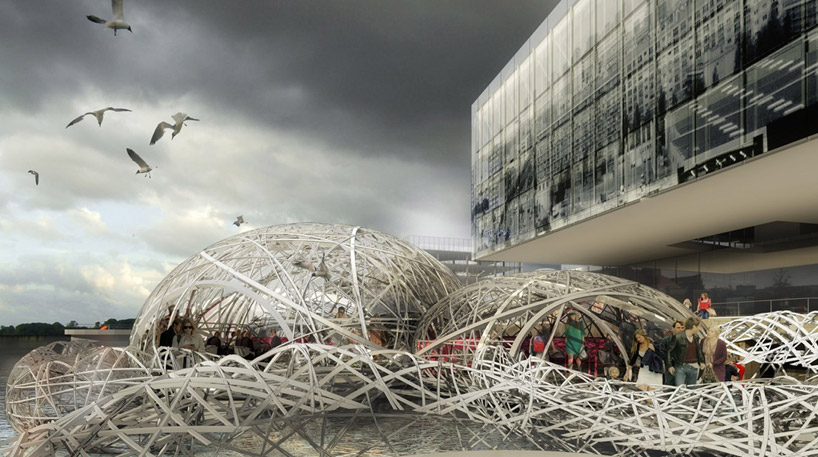 rhône saône dévéloppement, (prrivate, commercial) pavillon 8 + archipel restaurant, france, 2007 image courtesy of OBDC
rhône saône dévéloppement, (prrivate, commercial) pavillon 8 + archipel restaurant, france, 2007 image courtesy of OBDC
describe your style, like a good friend of yours would describe it.
ask my good friend. I don’t know. what I am very interested in when I design and conceive something, it is thinking about the close relationship between body and space. that’s why, for example the macro, I really wanted people to travel through the volume, to take different routes, moving the body through the museum and have a sense of discovery. I wanted the macro to act like a promenade, as if one is traveling through a country, but through a museum. it’s something that comes from very away. I love the ocean and to go further, beyond and maybe this is the sort of inspiration I use to try and make people move. maybe this is where I get my desire to try and make people move. I also feel that I grew up in a generation where we started to discover more and more, the moving image – cinema. when you think about quentin tarantino, robert altman… the way the camera is in a space or the way the different sequences are organized, films don’t explain how you pass from one place to another. you are just ‘there’ and then you are somewhere else. I like these kinds of transitions… and we are really trying to understand how this is done and how we can translate that through our architecture.
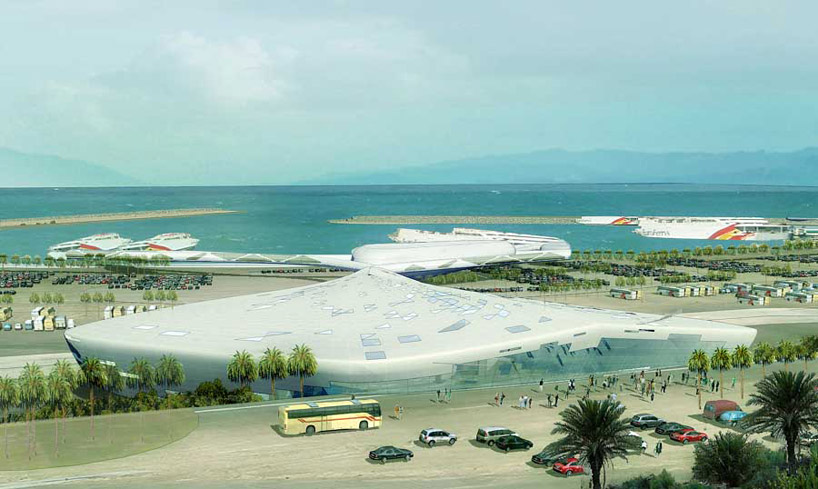 TMSA agence spéciale tanger méditerranée, (technical equipment and public facility) sea passenger terminal, morocco, 2007 image courtesy of OBDC
TMSA agence spéciale tanger méditerranée, (technical equipment and public facility) sea passenger terminal, morocco, 2007 image courtesy of OBDC
what project has given you the most satisfaction?
the next one? always the next one! for the moment, the macro. but the satisfaction is not from the building itself. it’s from the reaction of the people visiting the building. what was really, really moving me, was at the first opening in may, the day when it was open to the people of the city, when they came to me and said ‘thank you’ it gave me goosebumps, because I didn’t think they would tell me ‘thank you’ and it was really something impressive.
who would you like to design something for?
when I started my studies, when I finally decided to study architecture, I was thinking that I would like to build a theatre. but I have never built a theatre and I am not frustrated because I didn’t build a theatre. the next step is the next adventure, so it’s always exciting.that’s why I said when I choose a project it’s not a strategy of business, it’s not because we want this big or small project. I sometimes do very small projects without money, but it doesn’t matter to me if it’s exciting.
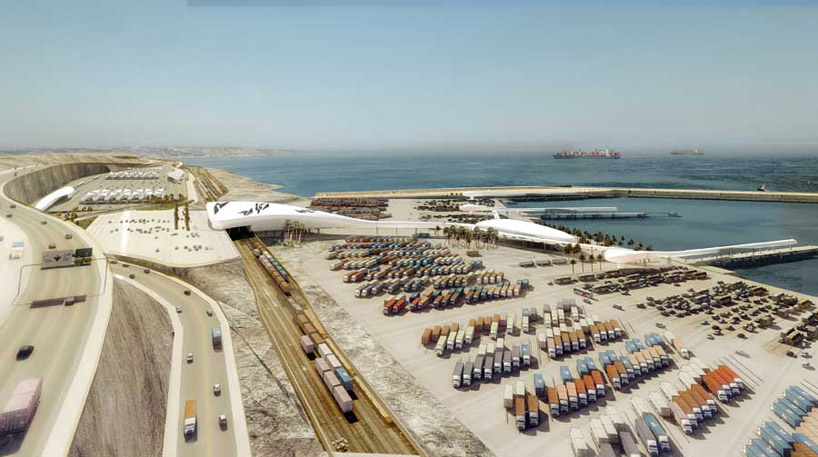 TMSA agence spéciale tanger méditerranée, (technical equipment and public facility) sea passenger terminal, morocco, 2007 image courtesy of OBDC
TMSA agence spéciale tanger méditerranée, (technical equipment and public facility) sea passenger terminal, morocco, 2007 image courtesy of OBDC
is there any designer and/or architect from the past, you appreciate a lot?
when I was a student I was looking a lot at frank lloyd wright, as well as mies van der rohe, because they were inventing what they called the ‘free plan’, and I was interested in this idea and how you pass through a plan without having different articulated space. it’s really influenced me I think, in the same way I was explaining cinema. there is no particular master. sometimes I am just impressed by buildings, and I am jealous about ideas expressed through these structures. I have three sites which I have visited that I am really impressed by.
the first is la tourette by le corbusier. I didn’t visit it as a student and a friend of mine from lyon was like, ‘you don’t know that place? you have to go.’ so we took the car and visited it. when we got there and I opened the door to the church chapel, and I was really taken over for 10 minutes. looking at the space I thought, ‘my god, I feel so small!’ it was such an impressive moment for me and I went back a second time for another occasion, and I didn’t want to re-enter the space because I wanted the feeling I had the first time, to remain intact.
the second one was la sagrada familia by antoni gaudí. it was when I was on an architectural tour with some architects in barcelona. we went by climbing the towers of the church, and it was windy. and through these towers there are these little holes on both sides as you climb the stairs, and you look through the void, and its really impressive. so it was really for me, crazy, this place. when we went back down, I said, ‘if this place is finished, it will be the end of the world.’ but now, it’s finished, and it’s not the end of the world, so… I made a mistake. but I still think that this place is absolutely incredible. the impression of this place was really strong on me.
the third one is a more recent building. it’s a tower of daniel libeskind’s jewish museum in berlin. the entrance corridor has a space with a slope, and the axis of the slope is not in the middle, it is oblique. so you move to take the slope and you want to climb, but at the same time your body is moving to the side. so you go further, but with your body coming back. it’s a very strange impression but the tower, it’s really impressive. you go in, and its concrete, and there’s nothing inside, and you are down, below the street and it’s enclosed, except a little triangle where the tools at the top is not, is open and you have the light coming from there and he left the little holes what you have in the concrete walls when you cool, when you put the concrete, without filling these holes, just at the level of the ground, so you have little, very little holes in it, that when light is coming in but you can’t look through because it’s above you, and the sun from the city is coming in. you feel that you are in earth, and you feel that the city is there, but you are in a void, and you are in a hole in a void in the city.
visiting these three buildings, I don’t really want to go back and disturb these initial impressions I have had.
and those still working / contemporary?
when I went to visit the guggenheim for the first time, I spent seven hours to walk through the space, meter by meter. I discovered as soon as I was walking one meter, the perspective, the space and the view was different. it was really incredible. but I discovered that at the end, I spent seven hours there! I think that it is an important piece of contemporary architecture.
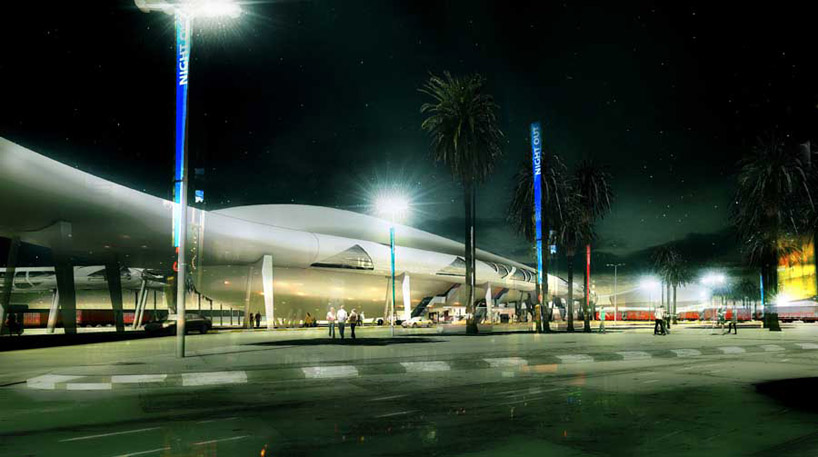 TMSA agence spéciale tanger méditerranée, (technical equipment and public facility) sea passenger terminal, morocco, 2007 image courtesy of OBDC
TMSA agence spéciale tanger méditerranée, (technical equipment and public facility) sea passenger terminal, morocco, 2007 image courtesy of OBDC
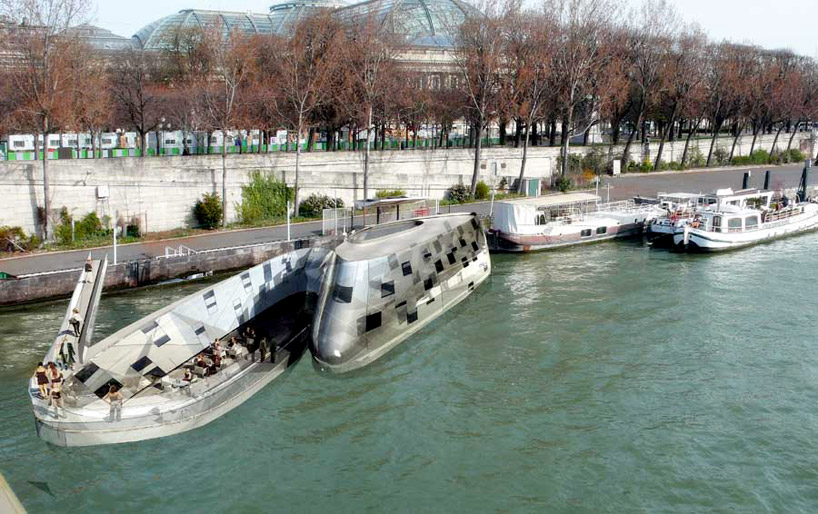 voies navigables de france, (private administrative buildings) VNF headquarters, france, 2008 image courtesy of OBDC
voies navigables de france, (private administrative buildings) VNF headquarters, france, 2008 image courtesy of OBDC
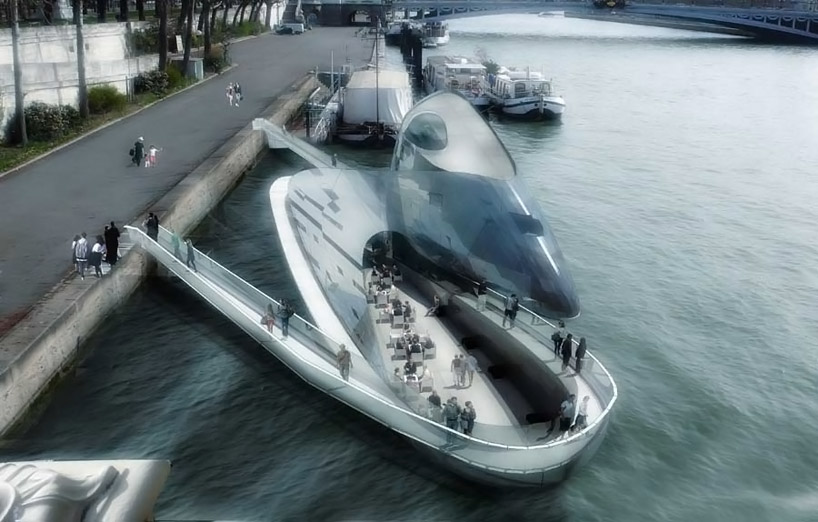 voies navigables de france, (private administrative buildings) VNF headquarters, france, 2008 image courtesy of OBDC
voies navigables de france, (private administrative buildings) VNF headquarters, france, 2008 image courtesy of OBDC
what advice would you give to the young?
to be curious. I always tell them that the most important thing is to stay curious all your life. to discover, to think that the world is nourishing you, and not only architecture, but the world and society around you is nourishing you, so you have to be curious. you have to always be curious about what will happen in the world later, and to be hungry for life, and to enjoy even when it’s hard work.
what are you afraid of regarding the future?
I am not afraid at all regarding the future, except of cowardice. the cowardice of people. because I think the world is more and more complicated, and in a way dangerous. because the people governing us are too cynical, and finance is the only economy we have – not producing anything. this is really dangerous because for the future you don’t know how the world will be governed in a way, and at the same time you have the impression that new generations, because they were living in a very comfortable situation, are not hungry enough. they think that the future will be so complicated that they won’t, they don’t want to think about it, because they don’t want to be aggressive, and I can understand that. at the same time, I am afraid of it, because if the young generation is not able to think that the future, to say that they want to build a different future, I don’t want to live in that future. I told that to the students. I started one or two semesters ago, with all those students of the school, telling them, ‘you have to be able to take risks. I want you to be courageous. I want you to have ideas, to take a position, because if you don’t do that, I will not want to live your future, in your world,’ and this is the only thing that is frightening me, but usually I am not afraid.

odile decq was born in france in 1955. she first began her studies at the university of rennes and obtained her diploma in architecture in 1978 from the university of paris, 6. the following year, she received a diploma in urban planning from the institute of political studies in paris. starting in 1980, odile decq worked alongside french architect benoit cornette. in which the pair created a studio together under the name of ODBC architectes urbanistes working together on such known projects as the banque populaire de l’ouest, administrative and social centre in rennes; three social housing projects in paris (1988, 1995, 1997); masterplan for the industrial harbour and docks of paris in gennevilliers. in 1996 OBDC was responsible for the exhibition scenography for the french pavilion at the venice architecture biennale when they were also awarded the golden lion, the highest honor given by the organization. the duo worked together until cornette’s death in 1998. since then decq has been involved in a number of international projects throughout asia and europe including: house for the CIPEA in ninjing, china; hausing buiding, florence, italy; FRAC, regional fund for contemporary art in rennes, france; and most recently the museum for contemporary art, rome.
architecture interviews (267)
odile decq (16)
PRODUCT LIBRARY
a diverse digital database that acts as a valuable guide in gaining insight and information about a product directly from the manufacturer, and serves as a rich reference point in developing a project or scheme.
